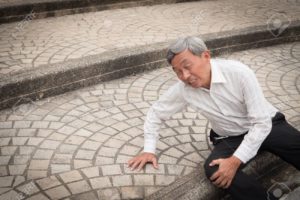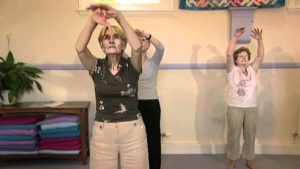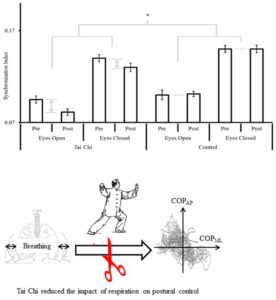Reduce Falls in the Elderly with Tai Chi Practice
By John M. de Castro, Ph.D.
“Seniors who practice tai chi – a Chinese meditation practice that combines deep breathing and slow, fluid movements – may be less likely to fall than their peers who don’t do this type of exercise.” – Lisa Rapaport
The process of aging affects every aspect of the physical and cognitive domains. Every system in the body deteriorates including motor function with a decline in strength, flexibility, and balance. Impaired balance is a particular problem as it can lead to falls. In the U.S. one third of people over 65 fall each year and 2.5 million are treated in emergency rooms for injuries produced by falls. About 1% of falls result in deaths making it the leading cause of death due to injury among the elderly.
Falls, with or without injury, also carry a heavy quality of life impact. A growing number of older adults, fear falling and, as a result, limit their activities and social engagements. This can result in further physical decline, depression, social isolation, and feelings of helplessness. It is obviously important to discover methods to improve balance and decrease the number of falls in the elderly.
Tai Chi training is designed to enhance and regulate the functional activities of the body through regulated breathing, mindful concentration, and gentle movements. It includes balance training and has been shown to improve balance and coordination. Indeed, Tai Chi training has been shown to reduce the frequency of falls in the elderly. It is not known, however, if Tai Chi training is better or worse than other exercises for reducing falls in the elderly.
In today’s Research News article “Effectiveness of a Therapeutic Tai Ji Quan Intervention vs a Multimodal Exercise Intervention to Prevent Falls Among Older Adults at High Risk of Falling: A Randomized Clinical Trial.” (See summary below or view the full text of the study at: https://www.ncbi.nlm.nih.gov/pmc/articles/PMC6233748/ ), Harmer and colleagues recruited health elderly individuals, 70 years of age or older, who had fallen at least once in the last year and randomly assigned them to one of three groups, Tai Chi, stretching exercise, or multimodal exercise including aerobic exercise, balance, flexibility, and strength exercises. All groups practiced twice a week for 1 hour for 24 weeks. The participants were measured before, in the middle, at the end of training, and monthly follow-up telephone calls for falls, fall injuries, physical performance, and cognitive function.
They found that during the 12 weeks of training and 6-month follow-up period that the group that practiced Tai Chi had significantly fewer falls and fewer falls that caused moderate or serious injuries than the multimodal exercise group which, in turn, had fewer falls and injuries than the stretching group. In addition, at the end of training the participants in the Tai Chi group and the multimodal exercise group had significantly greater improvements in cognitive and physical performance than the stretching group.
The results are interesting and important. They suggest that engaging in Tai Chi exercise reduces falls and improves physical and cognitive performance in the elderly and that Tai Chi exercise is superior to multimodal exercise and stretching in reducing falls. This is important because of the comparisons of types of exercise showed a significant superiority for Tai Chi Exercise. They are also important because of the severity of the consequences of falling for longevity, health, and well-being of the elderly. As an additional bonus Tai Chi exercise appears to reduce the cognitive decline that routinely occurs with aging.
It is important to recognize that Tai Chi is a gentle and safe exercise that is appropriate for all ages including the elderly and for individuals with illnesses that limit their activities or range of motion, such as stroke recovery. Also, Tai Chi is inexpensive to administer, can be performed in groups or alone, at home or in a facility, and can be quickly learned. In addition, it can be practiced in social groups. This can make it fun, improving the likelihood of long-term engagement in the practice. So, Tai Chi practice would appear to be an almost ideal gentle exercise to prevent falls in the elderly and improve their physical and cognitive health and well-being.
So, reduce falls in the elderly with Tai Chi practice.
“Balance training based on the Chinese martial arts discipline tai ji quan — better known as tai chi — reduced falling risks among the elderly more than conventional forms of exercise.” – Ashley Lyles
CMCS – Center for Mindfulness and Contemplative Studies
This and other Contemplative Studies posts are also available on Google+ https://plus.google.com/106784388191201299496/posts and on Twitter @MindfulResearch
Study Summary
Li, F., Harmer, P., Fitzgerald, K., Eckstrom, E., Akers, L., Chou, L. S., Pidgeon, D., Voit, J., … Winters-Stone, K. (2018). Effectiveness of a Therapeutic Tai Ji Quan Intervention vs a Multimodal Exercise Intervention to Prevent Falls Among Older Adults at High Risk of Falling: A Randomized Clinical Trial. JAMA internal medicine, 178(10), 1301-1310.
Key Points
Question
Is a fall prevention–specific tai ji quan intervention clinically more effective in reducing falls among older adults at high risk of falling than a stretching intervention (control) or a standard multimodal exercise intervention?
Findings
In a randomized clinical trial involving 670 adults 70 years or older with a history of falls or impaired mobility, the therapeutic tai ji quan intervention effectively reduced falls by 58% compared with the stretching exercise (control intervention) and by 31% compared with a multimodal exercise intervention.
Meaning
For older adults at high risk of falling, a therapeutically tailored tai ji quan intervention was more effective than stretching or multimodal exercises in reducing the incidence of falls.
Question
Is a fall prevention–specific tai ji quan intervention clinically more effective in reducing falls among older adults at high risk of falling than a stretching intervention (control) or a standard multimodal exercise intervention?
Findings
In a randomized clinical trial involving 670 adults 70 years or older with a history of falls or impaired mobility, the therapeutic tai ji quan intervention effectively reduced falls by 58% compared with the stretching exercise (control intervention) and by 31% compared with a multimodal exercise intervention.
Meaning
For older adults at high risk of falling, a therapeutically tailored tai ji quan intervention was more effective than stretching or multimodal exercises in reducing the incidence of falls.
Question
Is a fall prevention–specific tai ji quan intervention clinically more effective in reducing falls among older adults at high risk of falling than a stretching intervention (control) or a standard multimodal exercise intervention?
Findings
In a randomized clinical trial involving 670 adults 70 years or older with a history of falls or impaired mobility, the therapeutic tai ji quan intervention effectively reduced falls by 58% compared with the stretching exercise (control intervention) and by 31% compared with a multimodal exercise intervention.
Meaning
For older adults at high risk of falling, a therapeutically tailored tai ji quan intervention was more effective than stretching or multimodal exercises in reducing the incidence of falls.
Abstract
Importance
Falls in older adults are a serious public health problem associated with irreversible health consequences and responsible for a substantial economic burden on health care systems. However, identifying optimal choices from among evidence-based fall prevention interventions is challenging as few comparative data for effectiveness are available.
Objective
To determine the effectiveness of a therapeutically tailored tai ji quan intervention, Tai Ji Quan: Moving for Better Balance (TJQMBB), developed on the classic concept of tai ji (also known as tai chi), and a multimodal exercise (MME) program relative to stretching exercise in reducing falls among older adults at high risk of falling.
Design, Setting, and Participants
A single-blind, 3-arm, parallel design, randomized clinical trial (February 20, 2015, to January 30, 2018), in 7 urban and suburban cities in Oregon. From 1147 community-dwelling adults 70 years or older screened for eligibility, 670 who had fallen in the preceding year or had impaired mobility consented and were enrolled. All analyses used intention-to-treat assignment.
Interventions
One of 3 exercise interventions: two 60-minute classes weekly for 24 weeks of TJQMBB, entailing modified forms and therapeutic movement exercises; MME, integrating balance, aerobics, strength, and flexibility activities; or stretching exercises.
Main Outcomes and Measures
The primary measure at 6 months was incidence of falls.
Results
Among 670 participants randomized, mean (SD) age was 77.7 (5.6) years, 436 (65%) were women, 617 (92.1%) were white, 31 (4.6%) were African American. During the trial, there were 152 falls (85 individuals) in the TJQMBB group, 218 (112 individuals) in the MME group, and 363 (127 individuals) in the stretching exercise group. At 6 months, the incidence rate ratio (IRR) was significantly lower in the TJQMBB (IRR, 0.42; 95% CI, 0.31-0.56; P < .001) and MME groups (IRR, 0.60; 95% CI, 0.45-0.80; P = .001) compared with the stretching group. Falls were reduced by 31% for the TJQMBB group compared with the MME group (IRR, 0.69; 95% CI, 0.52-0.94; P = .01).
Conclusions and Relevance
Among community-dwelling older adults at high risk for falls, a therapeutically tailored tai ji quan balance training intervention was more effective than conventional exercise approaches for reducing the incidence of falls.
https://www.ncbi.nlm.nih.gov/pmc/articles/PMC6233748/Importance







